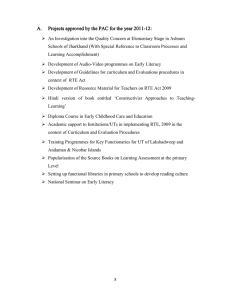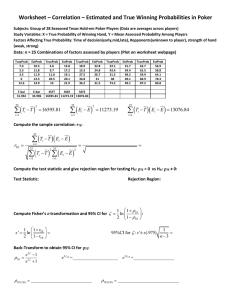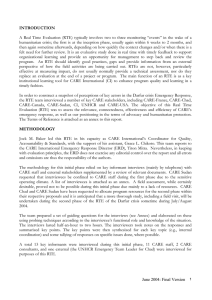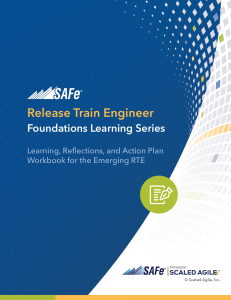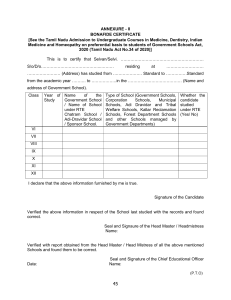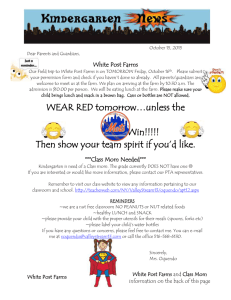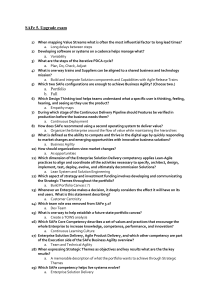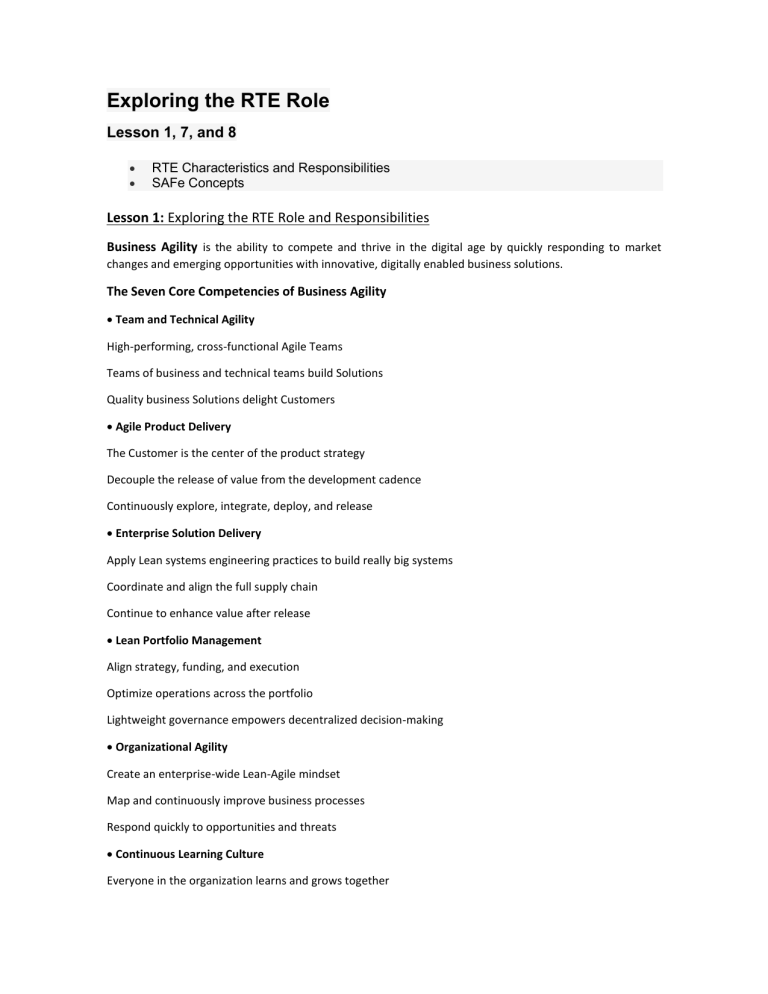
Exploring the RTE Role Lesson 1, 7, and 8 RTE Characteristics and Responsibilities SAFe Concepts Lesson 1: Exploring the RTE Role and Responsibilities Business Agility is the ability to compete and thrive in the digital age by quickly responding to market changes and emerging opportunities with innovative, digitally enabled business solutions. The Seven Core Competencies of Business Agility Team and Technical Agility High-performing, cross-functional Agile Teams Teams of business and technical teams build Solutions Quality business Solutions delight Customers Agile Product Delivery The Customer is the center of the product strategy Decouple the release of value from the development cadence Continuously explore, integrate, deploy, and release Enterprise Solution Delivery Apply Lean systems engineering practices to build really big systems Coordinate and align the full supply chain Continue to enhance value after release Lean Portfolio Management Align strategy, funding, and execution Optimize operations across the portfolio Lightweight governance empowers decentralized decision-making Organizational Agility Create an enterprise-wide Lean-Agile mindset Map and continuously improve business processes Respond quickly to opportunities and threats Continuous Learning Culture Everyone in the organization learns and grows together Exploration and creativity are part of the organization's DNA Continuously improving Solutions, services, and processes is everyone's responsibility Lean-Agile Leadership Inspire others by modeling desired behaviors Align mindset, words, and actions to Lean-Agile values and principles Actively lead the change and guide others to the new way of working To sum Up: Team and Technical Agility Agile Product Delivery Enterprise Solution Delivery Lean Portfolio Management Organizational Agility Continuous Learning Culture Lean-Agile Leadership Examine the responsibilities of the RTE role The RTE is the servant leader and coach for the ART Guides people in problem identification and decision-making Creates an environment of mutual influence Empathizes with others Encourages the personal development of teams Persuades rather than uses authority Applies systems thinking Supports the commitments made by the teams The RTE acts as the servant leader and coach for the ART Responsibilities of the RTE include: Managing and optimizing the flow of value through the ART Fostering collaboration between teams and ART stakeholders Facilitating PI (Planning Interval) Planning readiness and the event itself Tracking and communicating key ART execution Metrics Escalating and tracking ART impediments Facilitating relentless improvement for the ART Improving Relentlessly Facilitating PI Planning To sum up: Supporting PI Execution Release Train Engineer Optimizing Flow Coaching the ART RTE Behaviors Moving from a traditional mindset to a new one From… To… Coordinating team contributions Coaching the teams to collaborate Setting deadlines Aligning to objectives Driving toward specific outcomes Being invested in the ART's overall performance Knowing the answer Asking the teams for the answer Directing Letting the teams self-organize and hit their stride From fixing problems……to helping others fix them! SAFe Lean-Agile Mindset Principles 1. 2. 3. 4. 5. Precisely specify value by product Identify the Value Stream for each product Make value flow without interruptions Let the Customer pull value from the producer Pursue perfection Agile Values We are uncovering better ways of developing software by doing it and helping others do it. Through this work we have come to value: Individuals and interactions over processes and tools Working software over comprehensive documentation Customer collaboration over contract negotiation Responding to change over following a plan That is, while there is value in the items on the right, we value the items on the left more. Lesson 7: Serving the ART Explore the characteristics of a servant leader A servant leader knows that their own growth comes from facilitating the growth of others who deliver the results. The RTE is a servant leader The RTE focuses on optimizing the flow of value through growing and maturing the teams and roles on the ART. This is a challenging, large, and complex task The RTE will need coaching support from an on-site SAFe Practice Consultant (SPC) Eight Behaviors of Servant Leaders Behavior 1. Behavior: Listens and supports team members in decision identification In the context of SAFe: • Encourages everyone to express their opinions • Notices hesitant behavior and body language during SAFe events and meetings • Helps teams identify positive and negative changes during the Inspect & Adapt event 2. Behavior: Creates an environment of mutual influence In the context of SAFe: • Facilitates PI Planning and shared team events for all ART members and stakeholders • Asks for opinions/input and carefully considers the response 3. Behavior: Understands and empathizes with others In the context of SAFe: • Shares in celebrating every successful System Demo; feels bad about impediments, failures, etc. 4. Behavior: Persuades rather than uses authority In the context of SAFe: • Asks questions to encourage teams to look at decisions from new perspectives • Articulates facts; helps the teams see things they may have overlooked; helps rethink 5. Behavior: Encourages and supports the personal development of each individual In the context of SAFe: • Encourages team learning • Fosters collaborative practices like teamwork, Continuous Integration, collective code ownership, short design sessions, and specification workshops • Encourages rotation in technical areas of concern, such as functionality, components/layers, and role aspects • Facilitates team decision-making rather than making decisions for the teams 6. Behavior: Thinks beyond day-to-day activities; applies Systems Thinking In the context of SAFe: • Sets long-term operating goals for the team, such as Lean-Agile practices to master, new skills to acquire, etc. • Examines what is missing in order to make the environment better for everyone; prioritizes improvement activities and makes them happen 7. Behavior: Supports the teams’ commitments In the context of SAFe: • Facilitates ad-hoc meetings if needed • Helps teams access external sources of information like SMEs and shared resources (architects, UX designers, tech writers) • Helps clarify and articulate the rationale behind priorities, Milestones, and commitments • Helps teams prepare for System Demo • Helps teams find techniques to be more collaborative 8. Behavior: Is open and appreciates openness In the context of SAFe: • Shows appreciation for team members who raise serious issues • Encourages and facilitates open communication among team members • Encourages healthy conflict during team meetings • Gives open, honest opinions Evolving group dynamics Stages of high-performing teams 1. Forming: Forming teams Establishing ART Vision Establishing ART events Fostering collaboration 2. Storming: Surfacing and resolving team conflict Dealing with individual and team performance Fostering relentless improvement 3. Norming: Establishing the ART as a community Improving engineering practices Fostering effective communication 4. Performing: Creating space for spontaneous leadership and self-organization across the ART Creating a flow of knowledge across the teams and the ART The growth of individual teams in the ART progresses through each Tuckman stage, and so does the ART. The RTE facilitates and accelerates ART growth. Examine coaching techniques Coaching sometimes requires a shift from old behaviors to new ones From… -> To … Coordinating individual contributions -> Coaching the whole team to collaborate Acting as a subject matter expert -> Being a facilitator Talking about deadlines and technical options -> Focusing on business value delivery Driving ‘the right’ (your) decisions -> Doing the right thing for the business right now Fixing problems for others -> Facilitating team problem-solving From fixing problems… -> …to helping others fix them! Why are questions powerful? They provoke thought They generate curiosity in the listener They channel focus They generate energy and forward movement They stimulate reflective conversation They surface underlying assumptions They invite creativity and new possibilities They inspire more questions They help reach for deep meaning Powerful questions you can ask Powerful questions like these can help connect ideas and generate deeper insights. What new connections did you make? What had real meant to you? What surprised you? What challenged you? What’s missing from this picture so far? What is it we’re not seeing? Where do we need more clarity? What has been your major learning, insight, or discovery so far? What is the next level of thinking we need to do? What hasn’t been said that would help us reach a deeper level of understanding and clarity? What would you do if success were guaranteed? The five dysfunctions of a team 1. 2. 3. 4. 5. Absence of trust Fear of conflict Lack of commitment Avoidance of accountability Inattention to results Teamwork is the ultimate competitive advantage. However, many teams are dysfunctional. Absence of trust is the key problem that leads to the other four dysfunctions. The RTE can mitigate the five dysfunctions using SAFe 1. 2. 3. 4. 5. Absence of trust: The environment is safe. The team shares commitment and goals, displays hyper transparency, and engages in retrospectives. Fear of conflict: Scrum creates a safe environment for conflict; the SM/TC encourages discussion of disagreements. Shared commitment avoids individual conflict that occurs when objectives are not aligned. Lack of commitment: Teams make shared commitments to each other and to external stakeholders Avoidance of accountability: Stakeholders, peers, and review of results drive accountability. Inattention to results: Results are empirically reviewed at the end of every Iteration and release. Iteration Retrospectives drive continuous improvement. Explore group facilitation techniques Facilitating large groups Often during a PI, the RTE will be the facilitator for meetings and events with many people attending. Possible events are: Inspect & Adapt (I&A) Management review and problem-solving PI Planning ART Backlog refinement ART Sync Coach Sync Large group facilitation preparation and techniques Allow social networks to form. Everyone should be in a mindset of safety, and this happens through the natural formation of social networks. Provide clear instructions in writing, but offer no more than three steps at a time. Handouts are extremely helpful. Design, test, and leverage your audiovisuals. Optimize the physical spaces for maximum participation. Round tables and pods are best. Leverage the wall space as well. Use video conferencing tool features like polls that can simplify participation in virtual events. Timebox everything and use your tools to manage timeboxes. Call upon coaches in your organizations to help. You’ll need all the coaching power you can get! Create energy through fun! Identify the steps to create an ART with a one-team culture The ART as a tribe “A tribe is a group of people connected to one another, connected to a leader, and connected to an idea.” — Seth Godin, Tribes: We Need You to Lead Us Tribal unity: Steps to creating a one-team culture 1. Create a great team - Compose a SAFe Agile Team of ten or fewer individuals - Form via self-selection - Use Agile practices 2. Connect the teams and create a tribe - Share a collective identity - Share experiences - Celebrate as a tribe 3. Connect the tribe to its leader - Connect everyone to the leader during Gemba - Create an Agile Team of Agile leaders - Encourage vulnerability in front of the tribe 4. Connect the tribe to an idea - Have a vision - Communicate the vision - Learn together 5. Sustaining tribal unity - Quantify culture with an employee Net Promoter Survey (eNPS) - Record and share tribal legends - Set up successors for success 6. Engaging management in tribal unity - Tap into your empathy - Shine a light on a bright spot - Invite them into Gemba Lesson 8: Continuing Your Learning Journey 1. 2. 3. Create a personal RTE action plan Create an ART Improvement Roadmap Commit to the plans Applying SAFe Principles Lesson 3 and 4 Preparation Activities Facilitation Activities Planning Development Multi-location Facilitation Lesson 3: Organizing the ART Identify the characteristics of an effective ART organization ARTs are cross-functional A virtual organization of 5–12 teams (50–125+ individuals) Synchronized on a common cadence (a PI) Aligned to a common mission via a single ART Backlog Teams on the ART are organized for flow Stream-aligned team – Organized around the flow of work and can deliver value directly to the Customer or end user. Complicated subsystem team – Organized around specific subsystems that require deep specialty skills and expertise. Platform team – Organized around the development and support of platforms that provide services to other teams. Enabling team – Organized to assist other teams with specialized capabilities and help them become proficient in new technologies. Moving to Continuous Deployment and Release on Demand Organizations often migrate from component teams to other team types (usually stream aligned teams) as the ART matures Over time, organizations build the cross-functional skills required for stream-aligned teams through cross-training and pair programming As skills advance, carefully rotate team members between different component teams to spread knowledge Create Enablers to architect for deploying and releasing more frequently Examine key ART roles and responsibilities Roles on the ART 1. 2. 3. 4. 5. Release Train Engineer is a coach for the ART. Product Management owns, defines, and prioritizes the ART Backlog. System Architect provides architectural guidance and technical enablement to the teams on the train. The System Team provides processes and tools to integrate and evaluate assets early and often. Business Owners are key stakeholders on the ART. Key ART roles ART leadership is collaboratively handled by the three key ART roles, each focusing on one area. ART Execution: The RTE facilitates optimizing the flow of value through the ART. Content Management: Product Management is the internal voice of the customer on the ART. Design Authority: The System Architect defines the overall architecture for the system. Business Owners responsibility areas 1. 2. 3. 4. 5. Sponsoring Relentless Improvement Leading by Example Realizing Business Outcomes Engaging with Lean Portfolio Management Aligning Priorities & PI Planning The Business Owners can be identified by answering the following questions: Who can steer this train in the right direction, participate in planning and execution, and help eliminate impediments? Who can speak on behalf of development, the business, and the Customer? Who can approve and defend a set of PI plans, knowing that they will never satisfy everyone? Identify the responsibilities of the System Team The teams on the ART are collectively responsible for delivering larger system and Solution value. To support this work, a System Team is often formed to: Create and maintain infrastructure, including Continuous Integration, automated builds, and automated build verification testing Perform end-to-end system integration and Solution performance testing Assist in staging System Demos Support DevOps and CDP activities, including Release on Demand System Team responsibility areas 1. 2. 3. 4. 5. Facilitating Releases Building Development Infrastructure Supporting System and solution demos Supporting Solutions Integration Assisting with End-to-End Testing Balancing responsibilities The System Team can never be the entire solution to the integration challenge. Maximizing ART velocity requires a sense of balance between Agile Teams and the System Team. Best practices include: Shared non-functional requirement (NFR) testing across other teams and the System Team Shared understanding of infrastructure and tooling across the teams on the ART Shared necessity to avoid turning the System Team into a bottleneck Lesson 4: Planning a PI Identify preparation activities for the PI Planning event Preparing the ART Backlog for PI Planning In the weeks before PI Planning, Product Management does the final ART Backlog preparation with System Architects and ART stakeholders. RTEs will be more active in coaching a new ART when preparing the backlog Over time, the Product Management and the System Architect should be able to handle most of this preparation work The RTE will be one of the backlog stakeholders, often focused on infrastructure Enablers and improvement items
